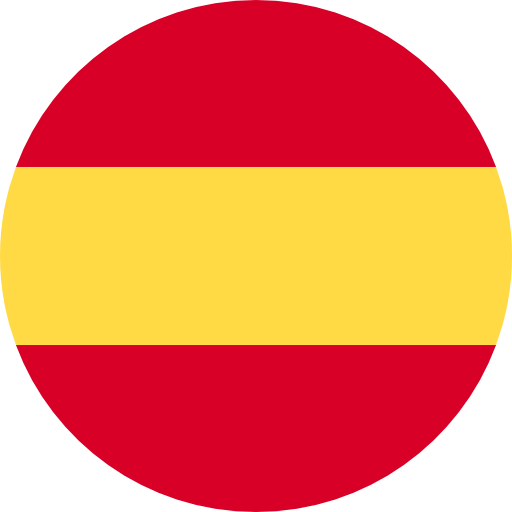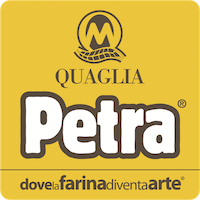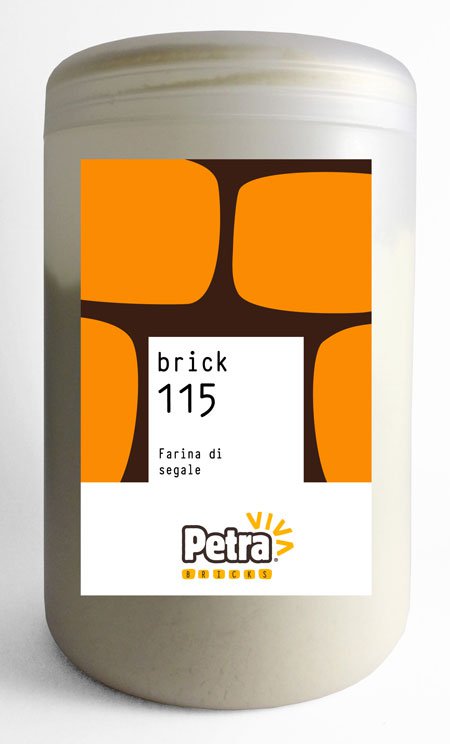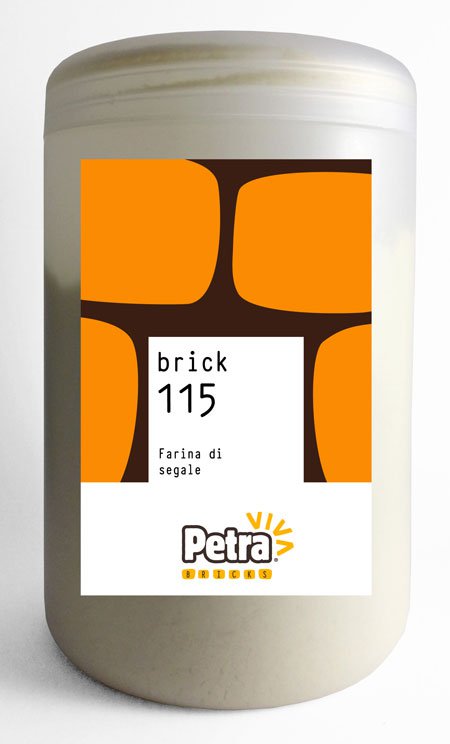It is one of the classical grains of ancient times. The cooking characteristics of rye flour are remarkably different from those of wheat flour. This is mainly due to the fact that in rye mixtures, the molecules of gluten (a sticky protein) cannot build any adhesive structure to trap gas because of the presence of pentosans (viscous substances). In rye these viscous substances carry out the same function of gluten in wheat. They are important to bind and retain water during the preparation of the dough and in cooking. Rye bakery products - unlike wheat products - are characterised by a darker, hard and aromatic dough. Rye bread is mainly made up of gelified starch; its crumb is more compact and it contains fewer holes, therefore it is less airy than in wheat bread. Rye flour is often used in multi-grain and wholegrain bread. From a nutritional point of view, rye is low in carbohydrate compared to other grains (65%) and high in protein (16%). It contains good amounts of lysine, an essential amino acid that is low in other grains. It has a fairly low amount of fat (2.6%).
RDA = DOSI GIORNALIERE RACCOMANDATE DI VITAMINE E MINERALI
L’RDA è la dose giornaliera media che incontra il fabbisogno nutritivo di quasi tutte le persone in buono stato di salute.
Come per le GDA, questo non significa che tali quantità debbano essere assunte ogni giorno. Rappresentano il consumo medio nell’arco di un periodo di tempo.
Quando il contenuto di una vitamina o di un sale minerale viene segnalato sull’etichetta, viene indicato come percentuale rispetto alla dose giornaliera raccomandata (RDA). Le vitamine e i sali minerali devono essere consumati in quantità specifiche per il corretto funzionamento delle reazioni metaboliche essenziali dell’organismo e il mantenimento di un buono stato di salute. Per questa ragione, le dosi di assunzione raccomandate sono più alte rispetto al fabbisogno medio della popolazione. in modo da eliminare i possibili casi di deficienza.
L’RDA è la dose giornaliera media che incontra il fabbisogno nutritivo di quasi tutte le persone in buono stato di salute.
Come per le GDA, questo non significa che tali quantità debbano essere assunte ogni giorno. Rappresentano il consumo medio nell’arco di un periodo di tempo.
Quando il contenuto di una vitamina o di un sale minerale viene segnalato sull’etichetta, viene indicato come percentuale rispetto alla dose giornaliera raccomandata (RDA). Le vitamine e i sali minerali devono essere consumati in quantità specifiche per il corretto funzionamento delle reazioni metaboliche essenziali dell’organismo e il mantenimento di un buono stato di salute. Per questa ragione, le dosi di assunzione raccomandate sono più alte rispetto al fabbisogno medio della popolazione. in modo da eliminare i possibili casi di deficienza.
GDA = ASSUNZIONI DI RIFERIMENTO DI UN ADULTO MEDIO = 2.000 kcal / 8.400 kj
i valori giornalieri di riferimento suggeriscono la quantità totale di energia e nutrienti che un adulto, in buono stato di salute, deve assumere quotidianamente.
Le linee guida per gli adulti si basano sui fabbisogni tipici di uomini e donne di 18 anni di età in buono stato di salute, di peso normale e/o per il mantenimento del peso. I valori di GDA per l’energia derivano dai fabbisogni medi stimati di popolazione per l’energia e tengono conto dei livelli attuali di attività e di stile di vita di un cittadino medio, che tende ad essere abbastanza sedentario. L’energia viene espressa comunemente in “kilocalorie” (Kcal) ma anche in “Calorie”: le espressioni sono equivalenti e comunemente utilizzate sulle etichette alimentari. Nel caso di una donna adulta la GDA per l’energia è stimata pari a 2000 Kcal, mentre tale valore incrementa a 2500 Kcal per un uomo adulto: questi valori sono utilizzati come riferimento per calcolare i valori giornalieri di riferimento. Quando non è possibile fornire linee guida separate per uomo e donna, le GDA per un soggetto adulto si basano sui valori di GDA per la donna, al fine di evitare un consumo eccessivo.
i valori giornalieri di riferimento suggeriscono la quantità totale di energia e nutrienti che un adulto, in buono stato di salute, deve assumere quotidianamente.
Le linee guida per gli adulti si basano sui fabbisogni tipici di uomini e donne di 18 anni di età in buono stato di salute, di peso normale e/o per il mantenimento del peso. I valori di GDA per l’energia derivano dai fabbisogni medi stimati di popolazione per l’energia e tengono conto dei livelli attuali di attività e di stile di vita di un cittadino medio, che tende ad essere abbastanza sedentario. L’energia viene espressa comunemente in “kilocalorie” (Kcal) ma anche in “Calorie”: le espressioni sono equivalenti e comunemente utilizzate sulle etichette alimentari. Nel caso di una donna adulta la GDA per l’energia è stimata pari a 2000 Kcal, mentre tale valore incrementa a 2500 Kcal per un uomo adulto: questi valori sono utilizzati come riferimento per calcolare i valori giornalieri di riferimento. Quando non è possibile fornire linee guida separate per uomo e donna, le GDA per un soggetto adulto si basano sui valori di GDA per la donna, al fine di evitare un consumo eccessivo.
Il germe di grano è uno dei costituenti della cariosside di frumento (dal 2% al 4% del peso di un chicco) ed è ricco di sostanze nutritive come aminoacidi, acidi grassi, sali minerali, vitamine del gruppo B e vitamina E.
Nelle farine di grano tenero raffinate non è presente perché durante la macinazione del chicco viene eliminato per aumentare i tempi di conservazione, dato che gli acidi grassi contenuti nel germe irrancidiscono rapidamente. Il germe di grano rappresenta una delle migliori fonti alimentari di vitamina, nota come potentissimo agente antiossidante, fondamentale nella lotta ai radicali liberi, nella difesa della salute e nella prevenzione dell'invecchiamento.
Oltre all'effetto antiossidante ricordiamo che il germe di grano contribuisce al rafforzamento delle difese immunitarie, alla lotta all’invecchiamento cellulare e ai radicali liberi. Esercita inoltre un' azione riequilibrante sul metabolismo, contribuisce a ridurre il senso di stanchezza, debolezza, mancanza di appetito e sbalzi d’umore.
I fiocchi di germe di grano sono inoltre gustosi e nutrienti anche nel latte, nello yogurt, in zuppe (meglio se aggiunto a fine cottura), minestre e nelle insalate (consumo max giornaliero consigliato 50 g.).
Nelle farine di grano tenero raffinate non è presente perché durante la macinazione del chicco viene eliminato per aumentare i tempi di conservazione, dato che gli acidi grassi contenuti nel germe irrancidiscono rapidamente. Il germe di grano rappresenta una delle migliori fonti alimentari di vitamina, nota come potentissimo agente antiossidante, fondamentale nella lotta ai radicali liberi, nella difesa della salute e nella prevenzione dell'invecchiamento.
Oltre all'effetto antiossidante ricordiamo che il germe di grano contribuisce al rafforzamento delle difese immunitarie, alla lotta all’invecchiamento cellulare e ai radicali liberi. Esercita inoltre un' azione riequilibrante sul metabolismo, contribuisce a ridurre il senso di stanchezza, debolezza, mancanza di appetito e sbalzi d’umore.
I fiocchi di germe di grano sono inoltre gustosi e nutrienti anche nel latte, nello yogurt, in zuppe (meglio se aggiunto a fine cottura), minestre e nelle insalate (consumo max giornaliero consigliato 50 g.).
Quando il chicco di grano viene lasciato germogliare, si trasforma in un serbatoio di sostanze ancora più preziose per la nostra salute.
Rispetto a un chicco secco, per esempio, il livello di calcio di un seme germinato passerà da 45 fino ad un massimo di 71 mg per 100 g, quello del fosforo da 423 fino ad un massimo di 1050 mg e quello del magnesio da 133 fino ad un massimo di 342 mg. L’aumento del contenuto di vitamine sarà del 20% per la vitamina B1, del 45% per la vitamina B5, del 200% per la vitamina B6, del 225% per la provitamina A, del 300% per le vitamine E e vitamina B2 e del 500% per la vitamina C. un aumento si verifica anche a livello degli aminoacidi essenziali: il contenuto di lisina, per esempio, sarà quintuplicato.
Rispetto a un chicco secco, per esempio, il livello di calcio di un seme germinato passerà da 45 fino ad un massimo di 71 mg per 100 g, quello del fosforo da 423 fino ad un massimo di 1050 mg e quello del magnesio da 133 fino ad un massimo di 342 mg. L’aumento del contenuto di vitamine sarà del 20% per la vitamina B1, del 45% per la vitamina B5, del 200% per la vitamina B6, del 225% per la provitamina A, del 300% per le vitamine E e vitamina B2 e del 500% per la vitamina C. un aumento si verifica anche a livello degli aminoacidi essenziali: il contenuto di lisina, per esempio, sarà quintuplicato.
La crusca di frumento è una fibra importante per mantenere in movimento il sistema gastro-intestinale e favorire la regolarità.
La crusca di frumento è un alimento dal basso valore nutritivo e dall'alto contenuto di fibre. È principalmente ricca di fibre e induce un maggior senso di sazietà senza, di fatto, nutrire. Le persone che hanno necessità di maggior motilità intestinale o chi voglia alleviare la fame nervosa, può trovarla utile come integratore della normale dieta quotidiana. Aggiunta agli impasti di pane, pizza e dolci lievitati (soprattutto in associazione con lievito madre vivo) contribuisce all'abbassamento dell'indice glicemico del prodotto finito. Inoltre per effetto del processo di lievitazione e successiva cottura degli impasti perde drasticamente i fitati inibitori della metabolizzazione di minerali come il calcio e lo zinco.
La crusca di frumento è un alimento dal basso valore nutritivo e dall'alto contenuto di fibre. È principalmente ricca di fibre e induce un maggior senso di sazietà senza, di fatto, nutrire. Le persone che hanno necessità di maggior motilità intestinale o chi voglia alleviare la fame nervosa, può trovarla utile come integratore della normale dieta quotidiana. Aggiunta agli impasti di pane, pizza e dolci lievitati (soprattutto in associazione con lievito madre vivo) contribuisce all'abbassamento dell'indice glicemico del prodotto finito. Inoltre per effetto del processo di lievitazione e successiva cottura degli impasti perde drasticamente i fitati inibitori della metabolizzazione di minerali come il calcio e lo zinco.
È uno dei cereali classici dell'antichità.Le proprietà di cottura della farina di segale sono sostanzialmente diverse da quelle della farina di grano. Questo dipende principalmente dal fatto che nella pasta di segale le molecole di glutine (una proteina collosa) non possono costruire alcuna struttura collante per il trattenimento dei gas a causa della presenza di pentosani (sostanze viscose). Queste sostanze viscose svolgono nella segale la stessa funzione del glutine nel grano. Sono importanti per legare e mantenere l'acqua durante la preparazione della pasta e nel processo di cottura. I prodotti da forno a base di segale si distinguono - contrariamente ai prodotti da forno a base di grano - per la pasta più scura, dura e aromatica. Il pane di segale è costituito principalmente da amido gelificato; la sua mollìca è più fitta e contiene meno pori, pertanto è meno aerata rispetto al pane di frumento. Spesso si producono con la farina di segale quindi pane multicereali e pane integrale. Dal punto di vista nutrizionale, la segale contiene meno carboidrati rispetto agli altri cereali (65%) e più proteine (16%). Contiene buone quantità di lisina, un amminoacido essenziale di cui sono carenti gli altri cereali. Ha un contenuto lipidico modesto (2,6%).
Le sue proprietà nutrizionali sono notevoli. E’ molto ricca di minerali quali calcio, ferro, fosforo ed è il cereale a maggior contenuto di fluoro, importante per la salute di ossa e denti. E’ una buona fonte di vitamine del gruppo B (in particolare di B1, importante per il metabolismo dei carboidrati e per l’attività dei nervi, dei muscoli e del cuore) e di vitamina E. La farina integrale di segale è ricca di fibra idrosolubile: i pentosani, che la caratterizzano, stimolano la corretta attività intestinale ed esercitano un’azione favorevole sul controllo dell’assorbimento di glucosio e di colesterolo, evitando bruschi rialzi della glicemia dopo il pasto.
Le sue proprietà nutrizionali sono notevoli. E’ molto ricca di minerali quali calcio, ferro, fosforo ed è il cereale a maggior contenuto di fluoro, importante per la salute di ossa e denti. E’ una buona fonte di vitamine del gruppo B (in particolare di B1, importante per il metabolismo dei carboidrati e per l’attività dei nervi, dei muscoli e del cuore) e di vitamina E. La farina integrale di segale è ricca di fibra idrosolubile: i pentosani, che la caratterizzano, stimolano la corretta attività intestinale ed esercitano un’azione favorevole sul controllo dell’assorbimento di glucosio e di colesterolo, evitando bruschi rialzi della glicemia dopo il pasto.
La fitasi è un enzima estremamente importante dal punto di vista nutrizionale in quanto è in grado di liberare il fosforo e i sali minerali presenti nel chicco sotto forma di fitati. I fitati sono molecole molto complesse in cui sali minerali, come calcio, magnesio o ferro, sono trattenuti all’interno di anelli di fosforo: il nostro organismo non riesce a rompere questi legami ed assorbirli. Addirittura queste strutture hanno proprietà antinutrizionali, perché formano legami molto stabili con altri minerali, sottraendoli all’assorbimento durante la digestione. Possiamo dire che in presenza di fitati non solo non riusciamo ad assorbire i preziosi nutrienti apportati dall’alimento, ma rischiamo di perdere anche altri minerali perché letteramente “sequestrati” da queste complesse strutture. Il processo di germinazione rompe i fitti e libera i sali minerali rendendoli "digeribili". Aumenta così la loro biodisponibilità, cioè la quantità che il nostro organismo assorbe durante la digestione.
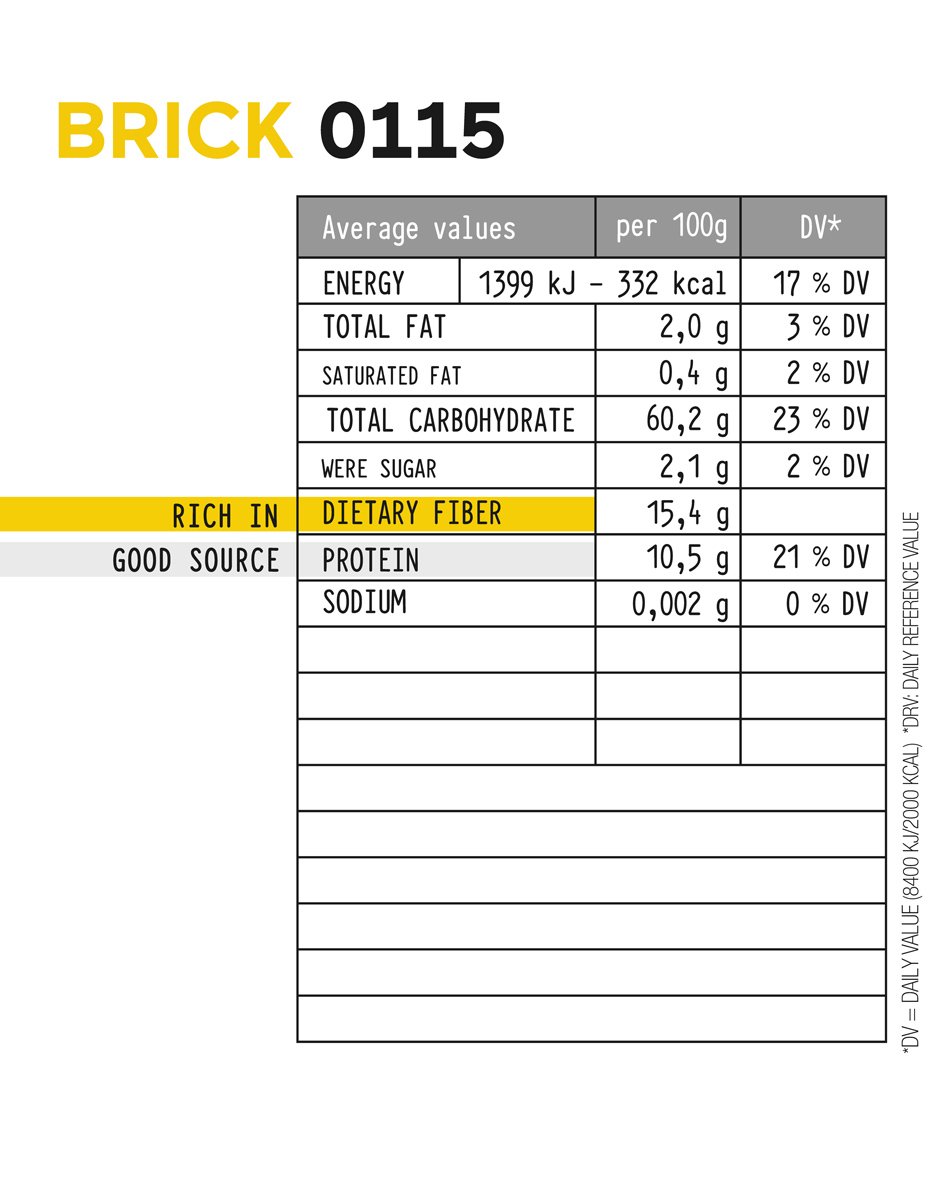
CHARACTERISTICS
Flour has a pleasantly strong typical note of rye.
The product is very rich in fibre because it contains 3 times the amount of fibre of wholegrain common wheat, in particular it is rich in the soluble fraction that increases the sense of satiety, modulates the absorption of sugar in the intestine and has a pre-biotic effect on the gut flora. Furthermore, it is rich in valuable mineral salts such as phosphorous, zinc, magnesium, as well as group B vitamin.
Its nutritional properties are remarkable. It is rich in minerals such as calcium, iron, phosphorous and it is the grain containing the highest amount of fluorine, which is important for the health of bones and teeth. It is a good source of group B vitamin (in particular B1, important for the metabolism of carbohydrates and for the activity of nerves, muscles and heart) and vitamin E. Rye wholegrain flour is rich in water soluble fibre: the pentosans it contains stimulate a correct gut activity and carry out a control activity on the absorption of glucose and cholesterol, thus preventing sudden glycemia increases after eating.
Flour has a pleasantly strong typical note of rye.
The product is very rich in fibre because it contains 3 times the amount of fibre of wholegrain common wheat, in particular it is rich in the soluble fraction that increases the sense of satiety, modulates the absorption of sugar in the intestine and has a pre-biotic effect on the gut flora. Furthermore, it is rich in valuable mineral salts such as phosphorous, zinc, magnesium, as well as group B vitamin.
Its nutritional properties are remarkable. It is rich in minerals such as calcium, iron, phosphorous and it is the grain containing the highest amount of fluorine, which is important for the health of bones and teeth. It is a good source of group B vitamin (in particular B1, important for the metabolism of carbohydrates and for the activity of nerves, muscles and heart) and vitamin E. Rye wholegrain flour is rich in water soluble fibre: the pentosans it contains stimulate a correct gut activity and carry out a control activity on the absorption of glucose and cholesterol, thus preventing sudden glycemia increases after eating.
SUGGESTIONS FOR USE
Ideal in combination with Petra.
Ideal in combination with Petra.
ADDITIONAL INFORMATION
Rye flour rich in dietary fibre and vitamin B1. Source of vegetable protein, phosphorous and vitamin B6.
Rye flour rich in dietary fibre and vitamin B1. Source of vegetable protein, phosphorous and vitamin B6.



